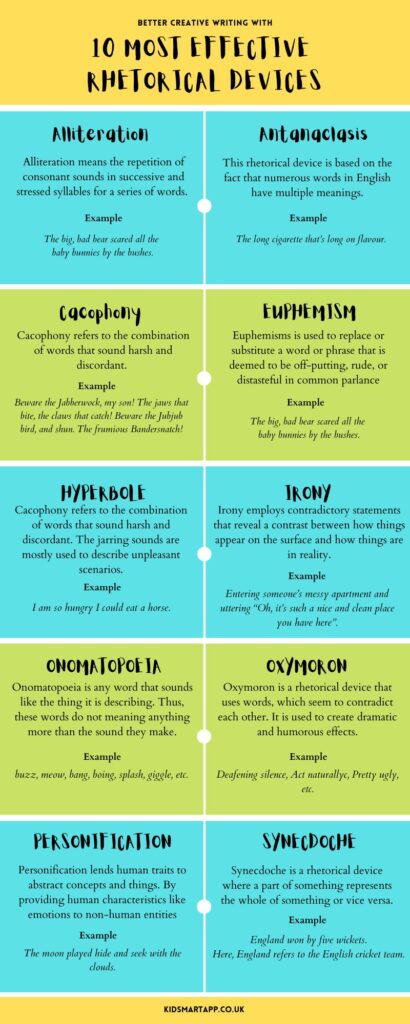1. Definition of Rhetoric
Rhetoric is the art of persuasive and effective communication, whether spoken or written. Aristotle defined it as “the faculty of observing in any given case the available means of persuasion.” It is not confined to political oratory but is a central tool in literature, philosophy, law, and everyday discourse.
2. Historical Background
- Greek Tradition: Plato, Aristotle, Isocrates explored rhetoric as a discipline.
- Roman Tradition: Cicero and Quintilian systematized rhetorical teaching.
- Renaissance: Erasmus, Thomas More, and Shakespeare used rhetoric extensively.
- Modern Era: Applied in literary studies, media, advertising, and cultural discourse.
3. The Three Modes of Persuasion
- Ethos – Persuasion through credibility and authority.
- Example: A doctor endorsing a medical product appeals to ethos.
- Pathos – Persuasion through emotions.
- Example: “If we don’t act now, future generations will suffer.”
- Logos – Persuasion through logic and evidence.
- Example: “According to research, 80% of accidents are caused by speeding.”
4. The Five Canons of Rhetoric
- Invention (Inventio) – Finding arguments.
- Arrangement (Dispositio) – Structuring arguments logically.
- Style (Elocutio) – Choosing words and figures of speech.
- Memory (Memoria) – Recalling and retaining content.
- Delivery (Pronuntiatio) – Effective vocal and physical expression.

5. Figures of Speech in Rhetoric (with Ample Examples)
Figures of speech are rhetorical tools that add beauty, emphasis, and persuasive force. They fall broadly into categories like figures of sound, figures of repetition, figures of contrast, figures of substitution, and figures of exaggeration.
A. Figures of Sound
- Alliteration – Repetition of consonant sounds at the beginning of words.
- Example: “She sells seashells by the seashore.”
- Literary Example: “From forth the fatal loins of these two foes” (Romeo and Juliet).
- Assonance – Repetition of vowel sounds.
- Example: “The rain in Spain stays mainly in the plain.”
- Literary Example: “And the silken sad uncertain rustling of each purple curtain” (Poe).
- Onomatopoeia – Words imitating sounds.
- Example: “The bees buzzed, the brook gurgled, the clock ticked.”
- Literary Example: “The moan of doves in immemorial elms” (Tennyson).
B. Figures of Repetition
- Anaphora – Repetition of a word/phrase at the beginning of successive clauses.
- Example: “I came, I saw, I conquered.” (Caesar)
- Literary Example: “It was the best of times, it was the worst of times…” (Dickens).
- Epistrophe – Repetition at the end of clauses.
- Example: “Government of the people, by the people, for the people.” (Lincoln).
- Symploce – Combination of anaphora and epistrophe.
- Example: “When there is talk of hatred, let us stand up and talk against it. When there is talk of violence, let us stand up and talk against it.”
- Chiasmus – Reversal of grammatical structure in successive phrases.
- Example: “Ask not what your country can do for you – ask what you can do for your country.” (Kennedy).
C. Figures of Contrast
- Antithesis – Contrasting ideas in parallel structures.
- Example: “Speech is silver, but silence is golden.”
- Literary Example: “To err is human; to forgive, divine.” (Pope).
- Oxymoron – Pairing contradictory terms.
- Example: “Deafening silence,” “bittersweet love.”
- Literary Example: “O brawling love, O loving hate!” (Romeo and Juliet).
- Paradox – A seemingly self-contradictory statement that reveals truth.
- Example: “The child is father of the man.” (Wordsworth).
D. Figures of Substitution
- Metaphor – Implied comparison between unlike things.
- Example: “Time is a thief.”
- Literary Example: “All the world’s a stage, and all the men and women merely players.” (As You Like It).
- Simile – Explicit comparison using like or as.
- Example: “Her smile was as bright as the sun.”
- Literary Example: “My love is like a red, red rose.” (Robert Burns).
- Metonymy – Substitution of one word with another closely associated.
- Example: “The crown” for monarchy, “the pen” for writing.
- Synecdoche – A part representing the whole or vice versa.
- Example: “All hands on deck” (hands = sailors).
E. Figures of Amplification
- Hyperbole – Exaggeration for emphasis.
- Example: “I’ve told you a thousand times.”
- Literary Example: “Love you till the seas go dry.” (Marvell).
- Litotes – Understatement using negation.
- Example: “He’s not a bad singer” (meaning he’s good).
- Euphemism – Polite expression replacing harsh reality.
- Example: “Passed away” for “died.”
F. Figures of Interruption and Omission
- Ellipsis – Omission of words understood in context.
- Example: “Some go to church, others to chapel.” (omitting go).
- Aposiopesis – Breaking off suddenly in speech.
- Example: “If you say that again, I’ll—!”
G. Figures of Address
- Apostrophe – Addressing an absent person or abstract concept.
- Example: “O Death, where is thy sting?” (Bible).
- Literary Example: “Milton! thou shouldst be living at this hour.” (Wordsworth).
- Personification – Attributing human qualities to non-human entities.
- Example: “The wind whispered secrets through the trees.”
6. Rhetoric in Literature
- Shakespeare: Soliloquies in Hamlet and Julius Caesar display rhetorical brilliance.
- John Milton: Uses classical rhetoric in Paradise Lost.
- Jane Austen: Employs irony as rhetorical persuasion in Pride and Prejudice.
- Political Speeches: Lincoln’s Gettysburg Address and MLK’s I Have a Dream stand as modern rhetorical masterpieces.
Conclusion
Rhetoric is more than ornamentation – it is the architecture of persuasion, clarity, and artistic beauty in language. By mastering rhetorical figures, English graduates gain sharper analytical tools and a deeper appreciation of literature and discourse.

